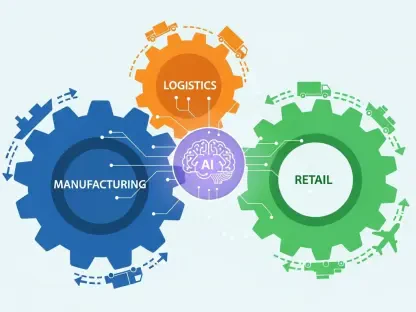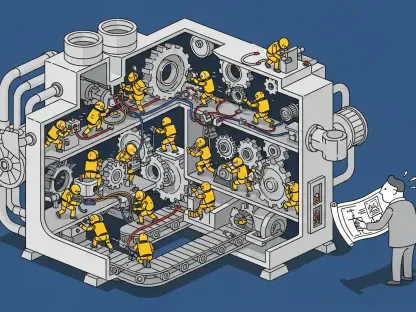In a bold move that has sent ripples through the tech industry, Huawei has open-sourced its Compute Architecture for Neural Networks (CANN) toolkit, positioning itself as a direct contender against NVIDIA’s long-reigning CUDA platform. Announced during a developer conference in Beijing, this strategic decision aims to disrupt a market where NVIDIA has held near-monopoly status in AI computing for almost two decades. CANN, designed specifically for Huawei’s Ascend AI GPUs, seeks to attract a global developer base by leveraging the collaborative power of open-source innovation. This development prompts a pressing question: can Huawei truly challenge an entrenched giant whose ecosystem is deeply embedded in the workflows of AI professionals worldwide? The stakes couldn’t be higher, as success could reshape the competitive landscape of AI technology. Beyond mere software rivalry, this move is intertwined with broader geopolitical tensions and China’s drive for technological self-reliance, setting the stage for a clash of innovation and established dominance that could redefine industry standards.
Technical Barriers in the AI Software Race
Huawei’s CANN toolkit, introduced several years ago, offers a promising framework with programming interfaces tailored for AI applications on Ascend GPUs, yet it faces a steep uphill battle against NVIDIA’s CUDA. CUDA’s strength lies in its two-decade head start, resulting in a polished ecosystem brimming with thousands of optimized libraries, comprehensive documentation, and seamless integration with NVIDIA hardware. For developers, this translates to a familiar and reliable environment where switching to an alternative like CANN involves not just learning new tools but risking compatibility issues and workflow disruptions. The technical gap is evident—while Huawei’s platform shows potential, it lacks the depth and refinement that CUDA has built over time. Closing this divide requires more than innovative coding; it demands creating an experience that rivals the ease and efficiency developers have come to expect from NVIDIA’s offerings.
Another dimension of this technical challenge is the sheer scale of developer loyalty CUDA commands. Many AI professionals have invested years mastering NVIDIA’s environment, with countless projects and models built specifically for its architecture. Transitioning to CANN isn’t merely a technical shift but a cultural one, as developers must weigh the cost of retraining against uncertain long-term benefits. Huawei must address these concerns by ensuring CANN not only matches CUDA in performance but also offers superior accessibility and support. Without robust tools and resources to ease migration, even the most advanced hardware risks being overlooked. The road ahead for Huawei involves meticulous attention to software maturity, prioritizing user experience to make CANN a viable contender in a space where familiarity often trumps innovation.
Geopolitical Forces Shaping Tech Rivalries
The decision to open-source CANN cannot be viewed in isolation from the broader geopolitical currents influencing global technology markets. With escalating tensions between the US and China, coupled with stringent export restrictions on Chinese tech firms, Huawei’s move aligns closely with China’s national agenda to achieve technological independence. This initiative reflects a concerted effort to reduce reliance on Western-dominated platforms like CUDA, especially as scrutiny of foreign tech intensifies within China. Recent actions, such as investigations into NVIDIA’s processors by Chinese authorities over security concerns, underscore a growing push for domestic alternatives. For Huawei, this isn’t solely about market share—it’s a critical step toward ensuring resilience in a landscape where access to cutting-edge technology is increasingly politicized.
Adding to the complexity, these geopolitical dynamics create both opportunities and obstacles for Huawei’s ambitions. On one hand, national support within China could accelerate CANN’s adoption among local developers and enterprises eager to align with domestic solutions. On the other, US sanctions limit Huawei’s ability to distribute hardware globally, potentially stunting the international reach of its ecosystem. Building a software platform that can thrive under such constraints requires not just technical prowess but also strategic navigation of regulatory and political challenges. Trust becomes a pivotal factor—convincing developers outside China to adopt CANN amid polarized tech alliances is no small feat. Huawei must balance domestic priorities with the need to appeal to a global audience if it hopes to mount a serious challenge to NVIDIA’s entrenched position.
Leveraging Open-Source for Ecosystem Growth
Huawei’s choice to make CANN freely available marks a calculated strategy to fast-track its adoption and build a robust developer community. By opening the toolkit to contributions from developers, academic institutions, and industry partners, Huawei aims to replicate the success of other open-source projects that have flourished through collective innovation. Eric Xu Zhijun, Huawei’s rotating chairman, highlighted the goal of making Ascend hardware “easier to use,” signaling a focus on accessibility to lower entry barriers for newcomers. This approach could foster rapid iteration and improvement of CANN, creating a dynamic ecosystem that evolves with user needs. If successful, this collaborative model might offer a fresh alternative to the proprietary constraints often associated with NVIDIA’s platform.
However, the open-source path is not without its challenges, as sustained engagement is crucial to its viability. Huawei must ensure active participation by providing high-quality documentation, responsive support, and regular updates to keep the community invested. Unlike established open-source giants, CANN starts with a smaller base of users, meaning Huawei needs to cultivate trust and demonstrate tangible benefits to attract contributors. The success of this strategy hinges on creating a virtuous cycle where developer input enhances the toolkit, which in turn draws more users. Additionally, integrating CANN with popular AI frameworks could tip the scales, making it a practical choice for diverse projects. This community-driven effort represents a pivotal opportunity for Huawei to build momentum, but only if it can maintain the delicate balance of openness and direction.
Market Dynamics and Hardware Potential
Industry perspectives on CANN’s ability to rival CUDA reveal a cautious optimism tempered by realistic hurdles. Analysts note that while open-sourcing the toolkit may help Huawei gain traction, replicating the depth of CUDA’s ecosystem—especially for advanced AI workloads like large language models—could take several years. NVIDIA’s platform benefits from widespread adoption and integration into existing developer pipelines, creating a high bar for any newcomer. Market acceptance of CANN will depend heavily on Huawei’s ability to provide not just competitive software but also a seamless transition for developers accustomed to CUDA’s environment. The journey to parity is long, and without significant incentives, many may hesitate to invest time and resources into an unproven alternative.
On the hardware front, Huawei shows notable promise that could bolster CANN’s appeal. Reports indicate that certain Ascend chips, such as the CloudMatrix 384, have outperformed NVIDIA processors in specific benchmarks, hinting at a narrowing performance gap. Yet, hardware excellence alone isn’t sufficient to sway the market—software stability, comprehensive integration, and compatibility with existing tools are equally critical. Developers need assurance that adopting Ascend GPUs with CANN won’t disrupt their workflows or compromise project outcomes. Huawei must pair its hardware advancements with a software experience that matches or exceeds industry expectations. If these elements align, the combination could position Huawei as a formidable player, but the path requires persistent investment in both technology and user trust.
Breaking Through Developer Inertia
NVIDIA’s CUDA maintains a formidable edge through a tightly knit ecosystem that effectively locks developers into its hardware via licensing restrictions and deep integration. This creates a systemic inertia that Huawei must overcome to make CANN a credible alternative. Convincing a global developer base to pivot away from a familiar and reliable platform involves addressing not just technical capabilities but also the psychological and practical barriers of change. Many AI professionals have built careers around CUDA, with projects and skill sets tailored to NVIDIA’s architecture. For Huawei, disrupting this status quo means offering undeniable advantages, whether through performance, cost, or ease of use, to justify the switch.
Geopolitical risks further complicate Huawei’s challenge, as US export controls limit the global distribution of Ascend hardware, potentially restricting CANN’s reach. Building trust internationally is paramount, especially in a climate where tech alliances are increasingly fragmented. High-quality documentation, active community support, and seamless integration into existing workflows are non-negotiable to win over skeptics. Huawei must also navigate the perception challenges tied to its national origins, ensuring that CANN is seen as a universal tool rather than a regionally focused solution. Overcoming these multifaceted barriers requires a long-term commitment to transparency and excellence, positioning CANN as a platform that transcends politics and prioritizes developer needs.
Strategic Steps for a Competitive Future
Looking back, Huawei’s decision to open-source CANN stood as a daring challenge to NVIDIA’s CUDA dominance, reflecting both technological ambition and geopolitical resolve. The initiative highlighted China’s push for self-reliance while showcasing the potential of collaborative development to disrupt entrenched ecosystems. Despite impressive hardware benchmarks with Ascend GPUs, the journey revealed significant gaps in software maturity and developer adoption compared to CUDA’s refined environment. Industry skepticism underscored the reality that technical parity alone wasn’t enough; building a vibrant community and seamless user experience proved equally vital. As Huawei navigated these hurdles, the effort marked a critical chapter in the evolving narrative of AI computing. Moving forward, the focus should center on sustained investment in ecosystem development, prioritizing accessible tools and global partnerships to bridge trust gaps. Strengthening CANN’s integration with popular frameworks and ensuring robust support could pave the way for broader acceptance, potentially reshaping competitive dynamics in the years ahead.









